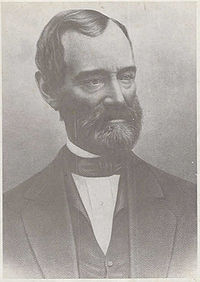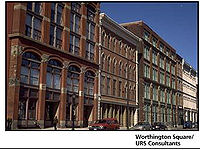
George Worthington
Encyclopedia

Cleveland, Ohio
Cleveland is a city in the U.S. state of Ohio and is the county seat of Cuyahoga County, the most populous county in the state. The city is located in northeastern Ohio on the southern shore of Lake Erie, approximately west of the Pennsylvania border...
, who founded the Geo. Worthington Company, a wholesale hardware and industrial distribution firm, in 1829 (until 1991 Cleveland's oldest extant business), as well as numerous banking and mining concerns, and contributed significantly to the early commercial and industrial development of Cleveland.
Early life and family
George Worthington was born in Cooperstown, New YorkCooperstown, New York
Cooperstown is a village in Otsego County, New York, USA. It is located in the Town of Otsego. The population was estimated to be 1,852 at the 2010 census.The Village of Cooperstown is the county seat of Otsego County, New York...
, to Clarissa (née Clarke) and Ralph Worthington, a banker and manufacturer, who had moved to Cooperstown from his birthplace of Colchester, Connecticut
Colchester, Connecticut
Colchester is a town in New London County, Connecticut, United States. The population was 14,551 at the 2000 census. In 2005 it was ranked 57th on the "100 Best Places to Live" in all of the United States, conducted by CNN...
, at a young age. Worthington was also second cousins with the American engineer Henry Rossiter Worthington
Henry Rossiter Worthington
Henry Rossiter Worthington was an American mechanical engineer. He had several inventions leading to the perfection of the direct steam pump , patented the duplex steam pump , and built the first duplex waterworks engine, widely adopted and used for more than 75 years...
of New York
New York
New York is a state in the Northeastern region of the United States. It is the nation's third most populous state. New York is bordered by New Jersey and Pennsylvania to the south, and by Connecticut, Massachusetts and Vermont to the east...
.
The Worthington family had resided in Connecticut
Connecticut
Connecticut is a state in the New England region of the northeastern United States. It is bordered by Rhode Island to the east, Massachusetts to the north, and the state of New York to the west and the south .Connecticut is named for the Connecticut River, the major U.S. river that approximately...
ever since Ralph Worthington's great-great-great grandfather, Nicholas Worthington, Esq., a Royalist
Cavalier
Cavalier was the name used by Parliamentarians for a Royalist supporter of King Charles I and son Charles II during the English Civil War, the Interregnum, and the Restoration...
during the English Civil War
English Civil War
The English Civil War was a series of armed conflicts and political machinations between Parliamentarians and Royalists...
, had fled England in 1649 (when his king Charles I
Charles I of England
Charles I was King of England, King of Scotland, and King of Ireland from 27 March 1625 until his execution in 1649. Charles engaged in a struggle for power with the Parliament of England, attempting to obtain royal revenue whilst Parliament sought to curb his Royal prerogative which Charles...
had been beheaded and the victorious Oliver Cromwell
Oliver Cromwell
Oliver Cromwell was an English military and political leader who overthrew the English monarchy and temporarily turned England into a republican Commonwealth, and served as Lord Protector of England, Scotland, and Ireland....
had confiscated his family lands) to settle in Saybrook, Connecticut, as one of the colony's founders.There is only circumstantial evidence that Nicholas held lands in England as he was not the head of the Worthington family in Lancashire, England.
George, like his father, left home at an early age and commenced his business career at Utica, New York
Utica, New York
Utica is a city in and the county seat of Oneida County, New York, United States. The population was 62,235 at the 2010 census, an increase of 2.6% from the 2000 census....
, in 1830, by entering the hardware store of James Sayer. There he remained four years when, having acquired a thorough knowledge of the business, he removed to Cleveland, where he established himself in business in 1835. Cleveland at that time was but a village, with a population of about seven hundred persons.
On November 16, 1840, Worthington married Maria Cushman Blackmar, and soon after moved into his newly constructed home on Euclid Avenue, the street which would, in the second half of the 19th century, come to be known as Millionaire's Row. Maria C. Worthington had eight children, five girls and three boys, one of each dying in infancy, leaving his two sons, Ralph and his younger brother, George, jr., to inherit their father's business interests upon his death in 1871.
Business
His first store occupied the ground on which now stands the Bethel Building; afterwards he purchased the stock of Cleveland, Sterling & Co., on the corner of Water and Superior streets, where the National bank buildings now stand, and associated with himself as business partner Mr. William Bingham. In 1841, Mr. Bingham sold out his interest.A few years later, Mr. Worthington associated with himself Mr. James Barnett (his cousin) and Mr. Edward Bingham. About 1862, Mr. Worthington projected the Cleveland Iron and Nail Works, and, in connection with Mr. William Bingham, matured the plans and in a year got the machinery into successful operation. Shortly after they built works for the manufacture of gas pipe. He was also largely interested in blast furnaces.
On the passage of the National Bank Law, Mr. Worthington, with other capitalists, organized the First National Bank of Cleveland. The bank was incorporated in 1863, and at the first meeting of the stockholders, held in June of that year, he was chosen one of the directors and elected president of the bank. This position he held until his death.
In 1865, Worthington was among the Cleveland businessmen who organized the Hahnemann Life Insurance Company (named for German physician Samuel Hahnemann
Samuel Hahnemann
Christian Friedrich Samuel Hahnemann was a German physician, known for creating an alternative form of medicine called homeopathy.- Early life :Christian Friedrich Samuel Hahnemann was born in Meissen, Saxony near Dresden...
), the first such firm in the U.S. to offer to insure those whose medical belief and practice were exclusively homeopathic, at lower rates than those subjecting themselves to traditional medical treatment; as some contemporary evidence showed a lower rate of mortality under the former. This was the first western insurance company admitted into the state of New York. Worthington was also a director of the Ohio Savings and Loan Bank, was for some years a director of the Cleveland, Columbus, Cincinnati & Indianapolis Railway Company, and was president of the Cleveland Iron Mining Company. In the development of the iron interests of Cleveland, which from a small beginning have since assumed such immense proportions, he was one of the pioneers.

Architecture and development
Generating annual revenues in excess of $1 million within a few years of its founding in 1829, the George Worthington Co. constantly required relocation to larger facilities. In 1882, the hardware wholesale turned industrial supply company moved into its last building on 820 St. Clair Avenue. Designed by the Cleveland architectural firm of Cuddell and Richardson, The George Worthington Building is noted as a "highly decorative brick structure notable for its unusually wide window bays grouped in two multi-story arched ranks, a brick cornice, recessed spandrels and finials." Having fallen into disrepair in the later half of the 20th century, the George Worthington Building was rehabilitated as modern loft apartments in 1996 on what is today Worthington Square, and is listed on the National Register of Historic Places as well as being a Cleveland Landmark.Worthington also did much in the way of building up the city, especially in the business portions, and owned at one point 14 buildings in what is today the Historic Warehouse District. He did much toward converting the village, as he found it, into the great city of today, being a man whose activity always led him to feel great pride in building up the town and setting men to work to improve his property. He strove, in many instances, to improve and advance the interests of the city, rather than his own personal or pecuniary interests.
Personal life
A man of large comprehension, bold and fearless in going into large operations, and liberal in his ideas in carrying them out—he was peculilarly adapted to enterprises of that character. He would often go in where others quailed, and was always bound to carry them to a successful issue. All in which he was engaged grew to be of great magnitude. The wholesale hardware business, which still bore his name until recent years, had become one of the largest in the country. As a business man he possessed superior qualifications, being a hard worker, shrewd, yet liberal, clear, positive, and of good judgement.A man well read, thoughtful and intelligent, he could comprehend and go into the details of all matters most thoroughly. As a companion he was agreeable, well versed in politics (in which his sentiments were strongly anti-slavery).
During the Civil War
American Civil War
The American Civil War was a civil war fought in the United States of America. In response to the election of Abraham Lincoln as President of the United States, 11 southern slave states declared their secession from the United States and formed the Confederate States of America ; the other 25...
, he was an active worker in everything that could tend to insure success to Union arms. To the cause, he have freely of his means and sacrificed both time and personal convenience.
In his commercial transactions, he was a man of justice, correctness, equity and high personal virtues. Kindly in his nature, he endeared himself to his business associates and intimate friends.
Religious life
At the time of his death he was a member of the Third Presbyterian Church of Cleveland, having been one of the thirteen who were set off from the Stone, or First Presbyterian Church, to build up the new church. The west window of the Third Presbyterian Church is a memorial to Mr. Worthington, put there by his widow and children who survived him. He came to the Stone Church by letter from the Presbyterian church of Utica, New YorkUtica, New York
Utica is a city in and the county seat of Oneida County, New York, United States. The population was 62,235 at the 2010 census, an increase of 2.6% from the 2000 census....
, with which he united during his clerkship in Utica. To the support of the church of his choice he gave liberally, and in her prosperity he took delight.
George Worthington is interred in the Worthington Mausoleum at the Lakeview Cemetery in Cleveland.

